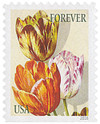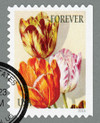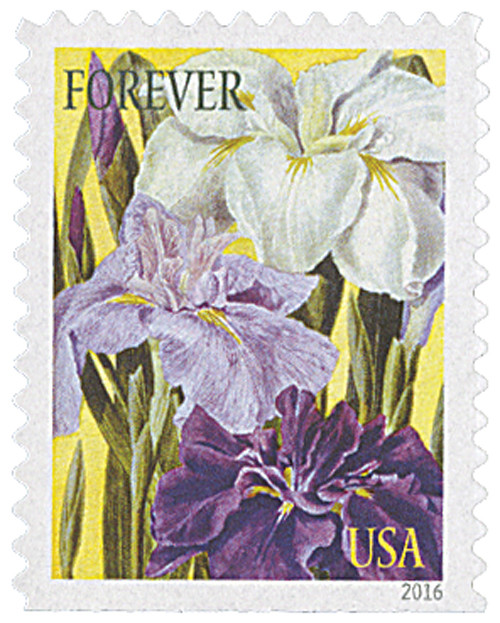
# 5049 - 2016 First-Class Forever Stamp - Botanical Art: Orange, Yellow and Purple Tulips
US #5049
2016 Tulips – Botanical Art
- Celebrates botanical artwork in American nursery catalogs printed between 1891 and 1912
Stamp Category: Definitive
Set: Botanical Art
Value: 49¢ First Class Mail Rate (Forever)
First Day of Issue: January 29, 2016
First Day City: Atlanta, Georgia
Quantity Issued: 60,000,000
Printed by: Ashton Potter
Printing Method: Offset
Format: Booklets of 10 OR Double-sided booklets of 20
Tagging: Nonphosphored type III, block tag applied
Why the stamp was issued: To continue the tradition of printing floral-themed US stamps.
About the stamp design: Pictures tulips from an American nursery catalog printed between 1891 and 1912. The catalog was from The New York Botanical Garden’s Nursery and Seed Catalog Collection.
First Day City: The First Day of Issue Ceremony was held at the American Philatelic Society’s AmeriStamp/Southeastern Stamp Expo. at the Hilton Atlanta in Atlanta, Georgia.
About the Botanical Art set: 10 stamps all picturing different artwork from a 100+ year old American nursery catalog. Species pictured include: corn lilies, tulips, dahlias, stocks, roses, Japanese irises, petunias, and jonquils.
History the stamp represents: At first sight, all but the most formal gardens may appear natural and effortless. The truth is garden design is an art involving both skill and careful planning.
When designing a garden, the first step is to identify the needs, goals, and desires of the people who will be using it. With those in mind, designers lay out the “hard landscape,” which may include paths, walls, decks, and seating areas.
To select suitable plants, factors such as hardiness zones, size and growth habits, and compatibility with neighboring plants must be considered.
Future maintenance is also key to designing a garden. Some plants spread quickly and may overtake a small garden. Annual plants must be replaced each year, while misjudging varying bloom times among perennials can lead to a colorless garden mid-season.
Location and soil type also influence garden design. Slopes, outcrops, and extreme exposure to wind are concerns that must be worked around.
Finally, the layout may begin. Depending on preferences, the garden may follow two major traditions – patterned along straight lines in the Persian and European style or naturalistic and asymmetrical. Both can offer escape and relaxation in an eye-pleasing oasis of natural beauty.
US #5049
2016 Tulips – Botanical Art
- Celebrates botanical artwork in American nursery catalogs printed between 1891 and 1912
Stamp Category: Definitive
Set: Botanical Art
Value: 49¢ First Class Mail Rate (Forever)
First Day of Issue: January 29, 2016
First Day City: Atlanta, Georgia
Quantity Issued: 60,000,000
Printed by: Ashton Potter
Printing Method: Offset
Format: Booklets of 10 OR Double-sided booklets of 20
Tagging: Nonphosphored type III, block tag applied
Why the stamp was issued: To continue the tradition of printing floral-themed US stamps.
About the stamp design: Pictures tulips from an American nursery catalog printed between 1891 and 1912. The catalog was from The New York Botanical Garden’s Nursery and Seed Catalog Collection.
First Day City: The First Day of Issue Ceremony was held at the American Philatelic Society’s AmeriStamp/Southeastern Stamp Expo. at the Hilton Atlanta in Atlanta, Georgia.
About the Botanical Art set: 10 stamps all picturing different artwork from a 100+ year old American nursery catalog. Species pictured include: corn lilies, tulips, dahlias, stocks, roses, Japanese irises, petunias, and jonquils.
History the stamp represents: At first sight, all but the most formal gardens may appear natural and effortless. The truth is garden design is an art involving both skill and careful planning.
When designing a garden, the first step is to identify the needs, goals, and desires of the people who will be using it. With those in mind, designers lay out the “hard landscape,” which may include paths, walls, decks, and seating areas.
To select suitable plants, factors such as hardiness zones, size and growth habits, and compatibility with neighboring plants must be considered.
Future maintenance is also key to designing a garden. Some plants spread quickly and may overtake a small garden. Annual plants must be replaced each year, while misjudging varying bloom times among perennials can lead to a colorless garden mid-season.
Location and soil type also influence garden design. Slopes, outcrops, and extreme exposure to wind are concerns that must be worked around.
Finally, the layout may begin. Depending on preferences, the garden may follow two major traditions – patterned along straight lines in the Persian and European style or naturalistic and asymmetrical. Both can offer escape and relaxation in an eye-pleasing oasis of natural beauty.















